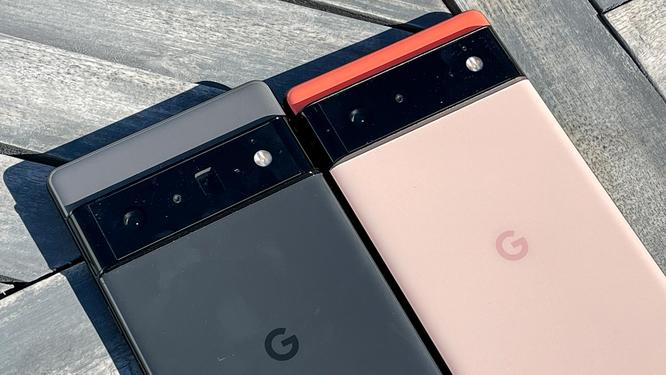www.androidpolice.com Google Pixel 7 & 7 Pro: Everything we know about Google's 2022 flagships
The Pixel 6 and Pixel 6 Pro won our hearts when Google dropped them back in October. Even though they're among the best Android phones you can buy, they aren't without their flaws. By swapping to its new Tensor custom chipset, the company was able to maximize performance for all sorts of AI-related features — seemingly at the cost of a whole slew of bugs and delayed updates. But it's a brand new year, and with the experience of 2021's flagships under its belt, Google is ready to aim onwards and upwards with the Pixel 7 series. Here's everything we know about the phones so far.
Google Pixel 7 series: Hardware
Last year, Google swung big with its design for the Pixel 6, giving the series a complete overhaul. From the controversial under-display fingerprint sensor — a first for the series — to the massive camera bar on the back of the phone, it seems like the company has finally cemented a new design for its in-house smartphones. Perhaps unsurprisingly, early leaks indicate Google isn't planning on changing much in the looks department, keeping a similar build for another year
ANDROIDPOLICE VIDEO OF THE DAY 3 Images ExpandExpandExpandWe've seen renders of both the Pixel 7 and Pixel 7 Pro, and comparing them to their predecessors is like playing a game of spot the difference. It's possible the smaller device may get a reduction in screen size — down to 6.3" from 6.4" — while the larger phone stays exactly the same. The camera bar is receiving a slight makeover, with the edges now flush with the band of the smartphone. This change removes an odd edge from the Pixel 6, appearing a little more reminiscent of Samsung's camera bump on its recent flagships. It also looks like the sensors are much larger, though it's possible the final product will disguise these lenses a bit more than what's seen in renders.
Meanwhile, the mmWave window along the tops of both models has been redesigned. On the Pixel 6 Pro — and specific carrier versions of the smaller Pixel 6 — it was a rather unsightly transparent window that clashed with the back of the phone. On the Pixel 7, we're looking at a much cleaner, smaller window built into the metal rail of each model. It's unclear if every Pixel model this year will support mmWave, or if the cheaper, smaller device will depend on carrier intervention. Whatever the case, it's good to see some improvements in its implementation.
3 Images ExpandExpandExpand
It might be early, but we have a pretty good idea as to what the Pixel 7's internals will look like, too. Unsurprisingly, Google is moving forward with a second-gen Tensor chipset — after all, I don't think anyone expected the company to call off its custom silicon efforts after just one generation. This GS201 chip, internally known as "Cloudripper," is paired with an unreleased "g5300b" Samsung modem. Expect the usual round of performance gains and improved camera processing, though we'll have to wait for more clues to make any further predictions.
Google Pixel 7 series: Software
Google's annual Pixel launch has often served as the perfect time for a major Android update to roll out to users, but it's unclear if that'll happen this year. We're still early into public previews for Android 13, but the dev timeline appears to suggest an earlier release date than usual this year.
It wouldn't be the first time Google has launched an update in the summer. Android 8.0 Oreo's announcement was timed perfectly to a solar eclipse in August 2018, launching just a few days later.
Whether or not Android 13 arrives alongside the Pixel 7 doesn't really matter to prospective buyers, of course. One way or another, these phones will absolutely come running the latest and greatest OS version when they arrive on store shelves.
Android 12 brought along a huge redesign with Material You, so we don't expect many visual changes with this year's update. That said, you never know what might pop up in future betas — especially after I/O later this spring.
Google Pixel 7 series: Availability & Price
Pixel flagships have always launched in October, and with the Pixel 6a seemingly on track for a late spring launch, it seems like that pattern will continue for another year. That said, the rumored Pixel foldable could throw a wrench into these plans, depending on when (and if) it finally rears its head. For now, there's no real reason not to expect a fall launch for the Pixel 7, but in this ever-changing world, there's always a chance something changes along the way.
As for how much the phones will cost, that's just speculation at this point. The Pixel 6 debuted at $599 and the Pixel 6 Pro at $899, and while inflation is rampant at the moment, Google appears pretty set on undercutting the competition with its device pricing. We wouldn't be surprised to see the Pixel 7 series debut at or slightly above their predecessors, around $629 or $649 and $929 or $949, respectively.
Software bugs aside, the Pixel 6 has laid a solid foundation for Google to build on in 2022. We'll have to keep waiting to find out what secrets lie with this year's flagship devices. If history's any indicator, we'll be seeing plenty of leaks along the way.
Samsung One UI 4.1 update makes its way to the Galaxy Note20 series Read NextShareTweetShareEmail Related TopicsAbout The AuthorWill Sattelberg(906 Articles Published)Will has been an Android enthusiast since he got his first smartphone in 2011. He loves watching movies, has a never-ending backlog of video games, and produces podcasts in his spare time. He lives in Buffalo, NY and is willing to give you chicken wing recommendations at any time. Just ask.








